31.01.2007
Corus Tournament in Wijk aan Zee: a Creative Survey (Rounds 5-6)
Round 5
A. Shirov (2715) – L. van Wely (2683) [B90]
The most spectacular game of this round did not need much of the winner's efforts. Alexey Shirov turned out to be evidently unprepared for a theoretical discussion, and we can only guess why he had decided to play such a crucial variation under those conditions. A very similar situation to Alexey's loss to Veselin Topalov in the previous round.
1.e4 c5 2.¤f3 d6 3.d4 cxd4 4.¤xd4 ¤f6 5.¤c3 a6 6.Ґe3 e5 7.¤b3 Ґe6 8.f3 Ґe7 9.Јd2 0–0 10.0–0–0 ¤bd7 11.g4 b5 12.g5 b4 13.¤e2 ¤e8
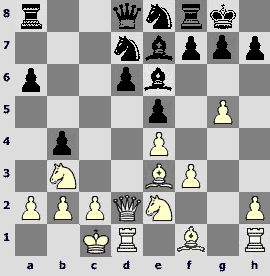
I have been suspecting for a long time that this knight's retreat is worth deepest investigation. I remember trying to prove this case to our St.Petersburg GMs Alexei Lugovoi and Vasily Yemelin during one of the Russia team championships about 5 years ago – in times immemorial, when out city still used to have a team to represent it with dignity.
14.f4. The most energetic move.Other possibilities – 14.ўb1, 14.h4 и 14.¤g3 – have also been tested by practice more than once.
14...a5 15.f5 a4 16.¤bd4 exd4 17.¤xd4 b3 18.ўb1 bxc2+ 19.¤xc2 Ґb3 20.axb3 axb3 21.¤a3 ¤e5 22.h4
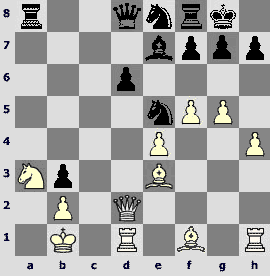
22...¦a4. The alternative here is 22...¦a5; a year ago, when Vishi Anand defeated Seryozha Kariakin here in Wijk aan Zee in a well-known game, he has employed the latter move.
23.Јg2 Јa8 24.f6 Ґd8 25.Ґd4 ¤c7 26.fxg7. Straightforward 26.Ґxe5 dxe5 27.Ґc4 won't do because of no less straightforward 27...¦xc4! 28.¤xc4 Јa2+ 29.ўc1 ¤e6, and Black develops an attack on the king.
26...ўxg7. Only a long computer analysis can ascertain what is really stronger: a course chosen by van Wely or a more traditional for such positions move 26...¦e8 without opening the kingside lines. The tactical ground for this move is a variation 27.h5 Ґxg5!, and Black has an enduring initiative.
27.h5. In practice this position was tested only once in the game of the players unknown to me. There in went on like this 27.Ґc4 ¤e6 [to the dynamic equality leads also 27...¦xc4!? 28.¤xc4 Јa2+ 29.ўc1 ¤b5 30.Ґxe5+ dxe5 31.ўd2 – it is necessary to save the king from checkmate – 31...Јa4! 32.¦c1 Ґa5+ 33.¤xa5 (on an immediate 33.ўe3 there is an answer 33...Ґc3) 33...Јxa5+ 34.ўe3 ¤d4 – White king is too far ahead, so the Black's counterplay seems enough for levelling] 28.Ґd5 with unclear play (Rohit – Karavade, Atul 2006).
27...¤e6
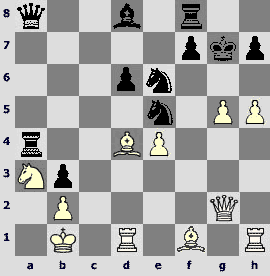
28.g6? Too reckless; 28.Ґxe5+ dxe5 29.g6 Ґg5 (to an unclear position leads 29...Јxe4+ 30.Јxe4 ¦xe4 31.h6+) 30.gxf7 ¦xf7 31.Ґb5 Јxe4+ 32.Јxe4 ¦xe4 33.Ґc4 ¦f6 34.Ґxb3 ¤d4 35.Ґd5 ¦e2 36.¤c4 Ґf4 37.¦he1 could have saved half a point.
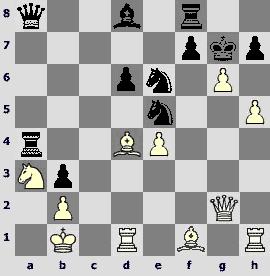
28...¦xd4! White's threats turns out to be an illusion. 29.¦xd4 ¤xd4 30.h6+ ўf6
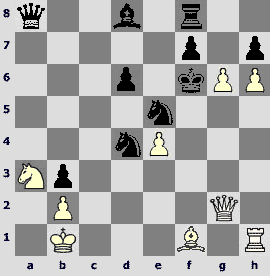
31.g7 ¦g8 32.Јf2+ ¤df3 33.Ґg2 Јxe4+ 34.ўa1 ўe6 35.¦f1 Ґg5 36.Ґxf3 Јxf3 37.Јxf3 ¤xf3 38.¦xf3 Ґxh6 39.¦xb3 ¦xg7 40.¦h3 Ґf4 0–1
S. Kariakin (2678) – A.Motylev (2647) [B12]
1.e4 c6 2.d4 d5 3.e5 Ґf5 4.¤f3 e6 5.Ґe2 ¤d7 6.0–0 ¤e7. Usually Blackdoes not permit to exchange his light-squared bishop, but Alexander Motylev demonstrates fine opening preparation, "outdoing" in this component Seriozha Kariakin, which is rarely to be seen.
7.¤h4
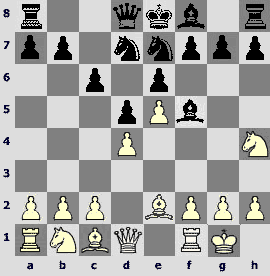
7...Ґe4! If 7...Ґg6 then 8.¤d2 c5 9.c3. After that White exchanges the g6-bishop, transfers the d2-knight to f3 and enjoys a comfortable advantage.
8.¤d2 c5 9.c3 ¤c6 10.¤xe4 dxe4 11.g3
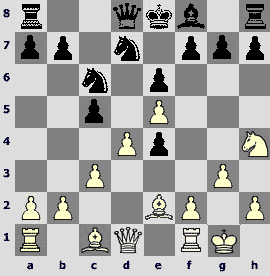
11...Јb6! A strong novelty, previously occurred 11...cxd4 12.cxd4 ¤b6 (Sutovsky - Palo, 2006) and now instead of 13.Ґb5? Ґe7 14.¤g2 0–0 15.Ґxc6 bxc6 16.¦e1 c5 with Black having good compensation for the pawn 13.Ґe3! permits to count on an advantage.
12.Ґe3 ¦d8. Black squarescrumble into pieces, there is a threat of ¤d7xe5!
13.Јa4 Ґe7 14.¦ab1. Choosing the lesser of two evils, after 14.¤g2 a resolute 14...Јxb2 15.Ґb5 Јxc3 could have followed.
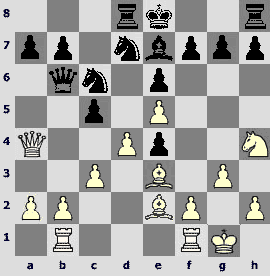
14...Ґxh4 15.gxh4 cxd4 16.cxd4 Јb4! 17.Ґb5. The play could have been a bit more interesting after 17.Јxb4 ¤xb4 18.f3, although the most probable outcome would be still a draw: 18...¤c2! (18...exf3 19.Ґxf3 ¤b6 20.Ґxb7 ¤c4 looks like a very crucial decision for Black) 19.ўf2 f6 20.¦bc1 ¤xe3 21.ўxe3 fxe5 (the most accurate move, 21...exf3 22.Ґxf3 fxe5 23.dxe5 permits White to keep some pressure on) 22.fxe4 exd4+ 23.ўxd4 ¤f6+ 24.ўe3 ўe7 – White advantage is pretty microscopic.
17...Јxa4 18.Ґxa4 ¤b6 19.Ґc2 ¤xd4 20.Ґxe4 ¤c4. The advantage of the two bishops is only a remembrance now, the position levels.
21.¦bd1
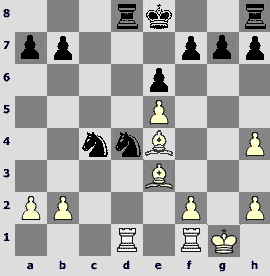
Here a draw was agreed. The boys decided not to indulge the spectators and did not take trouble to perform a following variation: 21...¤xe3 22.fxe3 ¤f5 23.¦xd8+ ўxd8 24.Ґxb7(rook ending after 24.Ґxf5 exf5 25.¦xf5 ўe7 is drawish, but visually more pleasant for Black – the e5-pawn is surely to be lost soon) 24...ўe7 25.¦c1 ¦b8 26.¦c7+ ўd8 27.¦xf7 ўe8 28.¦c7 ўd8, and it is impossible to avoid move repetition.Ѕ–Ѕ
S.Tiviakov (2667) – V.Topalov (2783) [C65]
Sergei Tiviakov had built an emphatically strong position, and even Veselin Topalov's furious push proved to be powerless against such play – an empty, tiresome draw, even if the game was long enough.
1.e4 e5 2.¤f3 ¤c6 3.Ґb5 ¤f6 4.d3 Ґc5
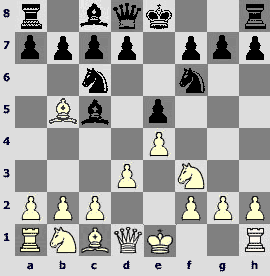
5.Ґxc6. White "emasculates" game with their 5th move already. 5...dxc6 6.Ґe3 Јe7 7.Ґxc5 Јxc5 8.¤c3 0–0 9.Јd2 a5 10.0–0 Јe7 11.Јg5 ¦e8 12.a4 h6 13.Јe3 b6 14.b3 Ґg4 15.¤d2 Ґe6 16.h3 ¤h5 17.¤e2 Јf6 18.f4 exf4 19.¤xf4 ¤xf4 20.Јxf4 Јc3 21.¦a2 ¦e7 22.¤f3 ¦d8 23.Јd2 Јc5+ 24.Јf2 Јxf2+ 25.ўxf2
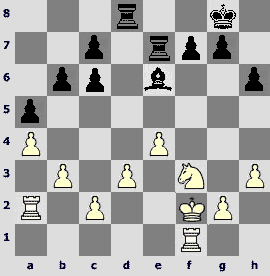
25...f5! Otherwise White would play g2-g4 with a lasting advantage. 26.exf5 Ґxf5 27.¦aa1 ¦de8 28.¦ae1 c5 29.¦xe7 ¦xe7 30.¤d2 ўf7 31.¤c4 Ґc8 32.¤e3 ўe8 33.h4 Ґb7 34.g3 ¦e6 35.ўe2 ¦g6 36.g4 ўe7 37.¤f5+ ўe6 38.¦f4 ўe5 39.ўe3 ¦f6 40.h5 ¦f7 41.¤h4 ¦xf4 42.¤g6+ ўe6 43.ўxf4 Ґc6 44.¤h4 ўf6 45.¤f5 Ґe8 46.¤g3 g5+ 47.hxg6 Ґxg6 48.¤e4+ ўe6 49.¤c3 Ґe8 50.¤e4 Ґg6 51.¤c3 Ѕ–Ѕ
D. Navara (2719) – Т.Radjabov (2729) [E61]
1.d4 ¤f6 2.¤f3 g6 3.c4 Ґg7 4.¤c3 0–0 5.Ґg5 c5 6.d5
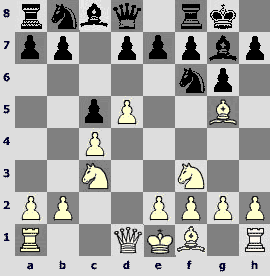
6...b5!? 7.¤xb5 ¤e4 8.Ґc1 a6 9.¤a3. The a3-knight is awful, but such is the price of the captured pawn.
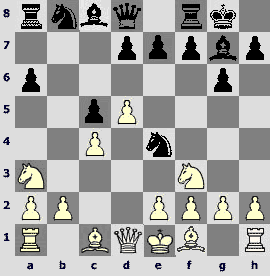
9...Јa5+? With this move Black manages to lose two tempi at once,the queen will soon have to retreat again. The right course would be 9...d6 or 9...e6, with compensation for the pawn.
10.¤d2 e6 11.g3 exd5 12.Ґg2 ¤xd2 13.Ґxd2 Јd8 14.cxd5 a5 15.Ґc3 d6 16.0–0 Ґa6 17.Јd2 Ґxc3 18.bxc3 ¤d7 19.¦ab1 f5 20.¤b5 ¤e5
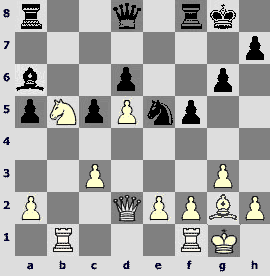
21.e4?? White commits suicide. There was a possibility to fortify the b5-knight with 21.a2-a4, after which Black has no compensation for a pawn.
21...¤c4 22.Јc1?! As White next move would show, he was not doing to rescue the b5-knight with ¤b5-a3 anyway; the more surprising then, that he rejects 22.Јh6!, as it seems impossible to win the knight comfortably, on 22...a4 [to a forced draw leads 22...fxe4 23.Ґxe4 Јe8 24.¤c7 Јxe4 25.¦be1 Јf5 26.¦e7 (loses 26.¤xa8 ¤e5) 26...¦f7 27.¦xf7 Јxf7 28.¤xa8 Ґb7 29.Јh4 Јxd5 30.Јd8+] follows 23.exf5, and the bishop from g2 to h3 and the rook from f1 to e1 get into the play effectively.
22...a4! The ground is cut from under b5-knight, tablesare turned.
23.exf5. White mechanically makes active moves. It was necessary to revalue the position and to choose defensive 23.¦e1 Јd7 24.¤a3, although after 24...¤e5 Black has a strong initiative.
23...Јd7 24.fxg6 Ґxb5 25.Јg5 ¤e5 26.gxh7+ ўh8 27.¦fe1 Ґd3 28.¦b6? [more stubborn is 28.¦bd1] 28...¦ae8 29.¦e3 ¤c4 30.¦xd3 ¦e1+ 31.Ґf1 Јh3 32.Јg8+ ¦xg8 33.hxg8Ј+ ўxg8 34.¦b8+ ўg7 0–1
R.Ponomariov (2723) – V.Kramnik (2766) [D45]
Ruslan Ponomariov's attempts to lead the game away from the main opening courses with 6.Ґd2 could bring nothing realizable, Vladimir Kramnik has levelled the game surely and easily.
1.d4 d5 2.c4 c6 3.¤c3 ¤f6 4.e3 e6 5.¤f3 ¤bd7 6.Ґd2 Ґd6 7.Ґd3 0–0 8.0–0 dxc4 9.Ґxc4 e5 10.Јc2 exd4 11.exd4 ¤b6 12.Ґb3 Ґg4 13.¤e5 Ґc7 14.Ґe3 Јd6 15.¤e4 ¤xe4 16.¤xg4 ¤f6 17.¤e5 ¤bd7 18.¤f3 ¤d5 19.Јf5. The position is absolutely equal, and the opponents decided not to torture each other. Ѕ–Ѕ
V. Anand (2779) – P. Svidler (2728) [C88]
Almost in every tournament Peter Svidler has his bad day. Unfortunately this has happened in Wijk aan See as well. It would be a pity if this "bad day for Beckham" prevents Peter from taking one of the top places. We wish to our grandmaster to cut off this bad habit. Then his results will be still better.
1.e4 e5 2.¤f3 ¤c6 3.Ґb5 a6 4.Ґa4 ¤f6 5.0–0 Ґe7 6.¦e1 b5 7.Ґb3 0–0 8.h3 Ґb7 9.d3 ¦e8 10.a4 h6 11.c3 b4 12.¤bd2 d5

13.a5! dxe4?! It seems to me, that with this exchange White is left with complete freedom of action, now his initiative on white squares develops very well. It was worth it to keep the tension with13...Јd7 or 13...Ґf8.
14.dxe4 Ґc5 15.Јe2 Јe7 16.¤h4 ¤d7? To let the knight get to f5 is in no way permissible, better indeed is 16...Ґc8, although the Black's position is still very unpleasant.
17.¤f5 Јf6 18.Јg4 ¤e7. Loses, but there is already no defense, for instance18...¦ad8 19.¤f3 ўh8 20.Ґg5!
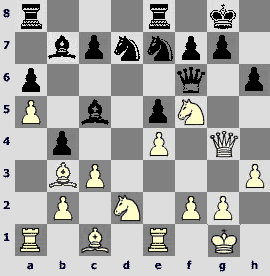
19.¤xh6+ Јxh6 20.Јxd7 ¦ed8?! Black has no compensation at all for the lost material, but why give up another couple of pawns?
21.Јxc7 1–0
L.Aronian (2744) – М.Carlsen (2690) [E15]
1.d4 ¤f6 2.c4 e6 3.¤f3 b6 4.g3 Ґa6 5.Јc2. This move, which is the evidence of White's willingness to part with a pawn in a couple of moves, has become popular only in 2006.
5...Ґb7 6.Ґg2 c5 7.d5!? exd5 8.cxd5 ¤xd5 9.0–0 Ґe7 10.¦d1 Јc8! Magnus's opening preparation is up to the mark.
11.Ґg5 h6 12.Ґxe7 ¤xe7 13.e4 0–0 14.¤c3 ¤bc6 15.¦d2 Ґa6
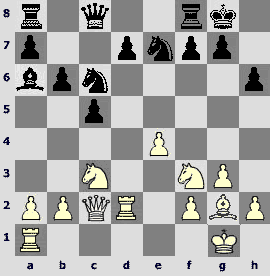
16.Ґh3. On 16.¦ad1 could have followed 16...Ґc4 with an idea of Ґc4-e6. The d7-pawn is untouchable (17.¦xd7 ¤d4), so White will have to make a move like17.e4-e5 and look for positional compensation for the pawns. It will be possibly enough for equality, but no more than that.
16...¤g6 17.Ґxd7 Јb7 18.Ґh3. Not dangerous for Black is 18.Ґxc6 Јxc6 19.¦ad1 Јe6, and there is a perceptible weakening of light-colored squares on the kingside.
18...¦ad8 19.¦ad1 Јb8 20.Ґg2 Ѕ–Ѕ
Round 6
A.Motylev (2647) – М.Carlsen (2690) [C48]
This game was rich in mistakes, but such was the nature of the struggle.
1.e4 e5 2.¤f3 ¤c6 3.¤c3 ¤f6 4.Ґb5 ¤d4 5.Ґa4 Ґc5 6.¤xe5 0-0 7.¤d3 Ґb6 8.e5
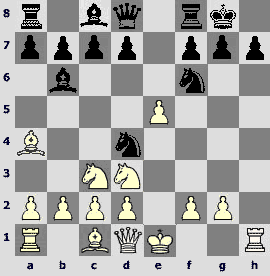
8...c6!? A healthy idea, in case of usual 8...¤e8 white knight rushes directly tod5.
9.0-0 To accept the offer is rather perilous:9.exf6 ¦e8+ 10.ўf1 Јxf6 with the strongest initiative for the piece. This position will surely be tested in practice more than once.
9...¤e8 10.¤e2 Јh4 11.¤xd4 Јxd4 12.Ґb3 d5 13.Јe2 f6 14.e6 ¤c7 15.c3 Јh4 16.g3 Јh6
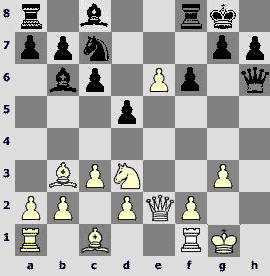
17.¤c5!? In this unusual way the problem of d3-knight is getting solved.
17...Ґxc5?! To simple equality leads17...¤xe6 18.¤xe6 (questionable is 18.¤xb7?!, because in that case Black can choose between18...¤f4 and 18...f5, getting a strong attack for his pawn in both occasions.) 18...¦e8 19.d4 Јh3
18.d4 Јh3 19.dxc5 ¤xe6 20.Ґe3 ¦e8 To move 20...b6 is to play on the wrong flank- after 21.cxb6 axb6 22.¦fe1 White chances seem better.
21.Јd2 ¤f8?! A very passive move, 21...¤g5! permitted to maintain the equality.
22.¦ae1 ¤g6 23.f3 h5?! Black position is worse, so he should have cared about levelling - 23...¤e5, preventing opening of the game with c3-c4. Then, after moving out his bishop to f5, Black gets close to equality.
24.Ґd4 Ґf5? Vitally necessary is 24...Ґe6, preventing c3-c4.
25.c4 ¤e7 26.¦e3 Ґe6? 26...Ґg6 27.¦fe1 Јd7 still permits to keep on fighting.
27.Јe2 A great advantage was also maintained after 27.¦fe1 ¤f5 28.¦3e2
27...ўf7 Also loses 27...¤f5 28.¦xe6 ўf7 29.cxd5 ¤xd4 30.Јd3
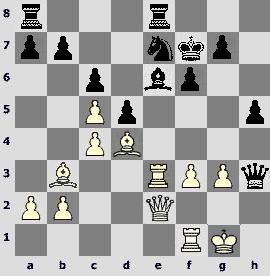
28.g4? Alexander's wicked time trouble begins to tell, primitive28.¦e1 ¤f5 29.cxd5 wins.
28...¤g6?! A correct move is 28...hxg4 29.f4 g3 30.¦xg3 Јh7, with fine play on light-colored squares.
29.f4 Ґxg4
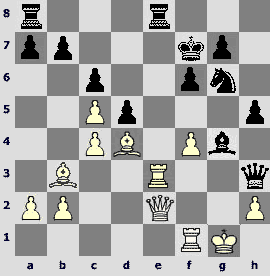
30.cxd5? Now White is left with nothing; to find 30.f5! during the time trouble is impossible, but exactly in that way White gets an advantage: 30...¤e5 (in the variation 30...Ґxe2 31.fxg6+ ўxg6 32.¦xh3 Ґxf1 33.ўxf1 dxc4 34.Ґxc4 ¦ad8 35.Ґc3 white bishops are stronger than black rook.) 31.cxd5 Ґxe2 32.d6+ ўf8 33.¦xh3 Ґxf1 34.ўxf1 g6 35.fxg6 ўg7 36.Ґc2, and Black is in for a difficult defense.
30...Ґxe2 31.dxc6+ ўf8 32.¦xh3 Ґxf1 33.ўxf1 bxc6 34.f5 ¤f4 35.¦h4 ¤d3 36.Ґe6 ¦ab8 37.¦xh5 ¦b4? [An oversight, 37...¤f4 38.¦h8+ ўe7 39.¦xe8+ ¦xe8 40.Ґb3 ¦h8 permitted to hope for a success.] 38.¦h8+ ўe7
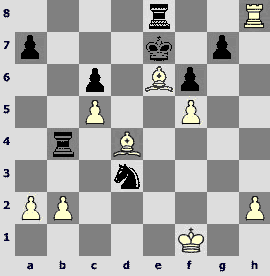
39.Ґxf6+ ўxf6 40.¦xe8 ¦xb2 41.¦f8+ ўe5 42.¦f7 ¤xc5 43.¦xg7 ¦xh2 44.¦xa7 ¤xe6 1/2-1/2
P.Svidler (2728) – L.Aronian (2744) [C88]
1.e4 e5 2.¤f3 ¤c6 3.Ґb5 a6 4.Ґa4 ¤f6 5.0-0 Ґe7 6.¦e1 b5 7.Ґb3 0-0 8.h3 Ґb7 9.d3 d6 10.a4 ¤a5 11.Ґa2 b4 12.¤bd2 c5 13.c3 ¦c8 14.cxb4 cxb4 15.¤f1 d5 16.exd5 b3 17.Ґxb3 ¤xb3 18.Јxb3 Јxd5 19.Јxd5 ¤xd5 20.¤xe5 ¤b4 21.¤g6 hxg6 22.¦xe7 Ґc6 23.b3 ¦fd8 24.¦a7 ¦d7 The whole game rolls smoothly along the classic tracks,the activity of black pieces should be enough for the draw, and then out of the blue there follows 25.Ґe3?
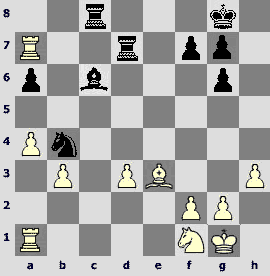
Such a nice blunder which immediately turns White from an offender into a defender.
25...Ґb7! 26.¤d2 ¤c6 27.¦xb7 ¦xb7 28.¦c1 ¦bb8 Stronger is 28...¤e7 29.¦xc8+ ¤xc8 30.Ґc5 ¤e7 31.d4 ¤d5, and the situation looks better for Black
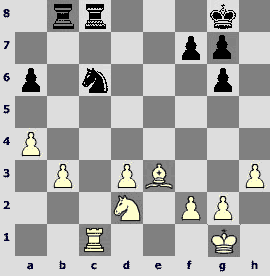
29.¤e4! A most important move, knight rushes toс5, and bad times for White are over.
29...¤d8 30.¦xc8 ¦xc8 31.¤c5 a5 32.d4 ўf8 Here a draw was agreed. It seems justified, as after, for example, 33.ўf1 ўe7 34.ўe2 ўd6 35.ўd3 ўd5 36.¤e4 ¤c6 37.¤c3+ ўd6 38.Ґf4+ ўd7 there is a variety of possible move repetitions or perpetual checks with knights.1/2-1/2
T.Radjabov (2729) – R.Ponomariov (2723) [E15]
1.d4 ¤f6 2.c4 e6 3.¤f3 b6 4.g3 Ґb4+ 5.Ґd2 Ґxd2+ 6.Јxd2 Ґa6 7.b3 d5 8.cxd5 exd5 9.¤c3 c5 10.Ґg2 Ruslan provokes Teimour to transposition into an endgame 10.Јe3+ Јe7 11.Јxe7+ ўxe7, but Teimour does not yield to the temptation of simplifying the position in spite of his confident leadership in the tournament. Welldone!
10...¤c6 More natural and safe is 10...0-0, and only after 11.0-0 ¤c6
11.¤e5 Teimour makes good use of his chances, although he could have simply played 11.0-0, after which Black also have to castle, as 11...¤e4?! is bad because of 12.Јe3 f5 13.¦fd1 0-0 14.dxc5
11...¤xd4 12.e3 ¤e6 13.¤xd5 0-0 14.¤c6 Јe8 15.¤xf6+ gxf6
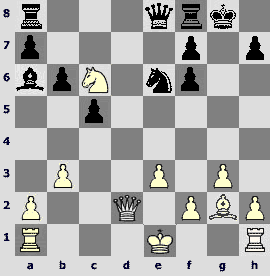
16.0-0-0 A crucial point of the game: White is inaccurate, and the game simplifies. Stronger is 16.Јd6!, which immediately secures the e7-square for the possible retreat of the knight. In the following complex struggle White chances would be preferable.
16...¦c8 17.Јd7 To the forced draw leads 17.Јd6 ¦c7 18.f4 Ґb7 19.f5 ¦xc6 20.Ґxc6 Јxc6 21.Јxc6 Ґxc6 22.fxe6 Ґxh1 23.exf7+ ўxf7 24.¦xh1; after 17.Јd7, that has happened in the actual game, could have followed 17...¦c7 18.Јxe8 ¦xe8 19.¦d6 ¦ec8 (Tempting is 19...Ґb7 , but after 20.¦hd1 a6 (in the variation 20...¦ec8 21.¤xa7 Ґxg2 22.¤xc8 ¦xc8 23.¦xb6 the rook and pawns are stronger than two minor pieces) White finds 21.Ґd5! , and due to the idea of exchanging the bishop on e6 and introducing the knight to d8 White is able to hold his own.) 20.¦hd1 Ґb5 21.¤d8 ¤xd8 22.¦xd8+ ¦xd8 23.¦xd8+ ўg7, and the draw is near. 1/2-1/2
V.Kramnik (2766) – V.Anand (2779) [E05]
A brilliant game for Vladimir Kramnik, who subtly outplayed the "bullet-proof" Vishi Anand.
1.d4 ¤f6 2.c4 e6 3.g3 d5 4.Ґg2 Ґe7 5.¤f3 0-0 6.0-0 dxc4 7.Јc2 a6 8.Јxc4 b5 9.Јc2 Ґb7 10.Ґd2 ¦a7 11.¦c1 Ґe4 12.Јb3 ¤c6 13.e3 Јa8 14.Јd1 ¤b8 15.Ґa5 ¦c8
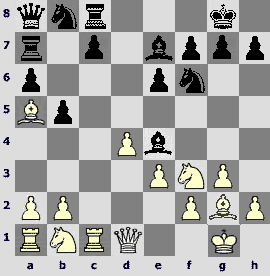
16.a3! A novelty, White takes under his control the b4-square, which is extremely important in this variation.
16...Ґd6 17.¤bd2 Ґd5

18.Јf1! With this move White solves his main problem of undefended g2-bishop.
18...¤bd7 19.b4 Naturally,c7-c5 is to be prevented.
19...e5 20.dxe5 Ґxe5 In case of seemingly evident 20...¤xe5 White is ready to intensify his pressure along the c-file after 21.¤xe5 Ґxe5 22.¦a2!
21.¤xe5 ¤xe5
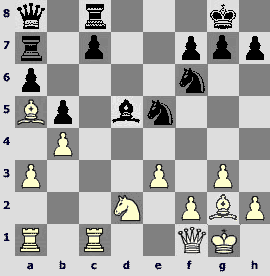
22.f3! After this magnificent move White's advantage becomes noticeable.
22...¤c4 23.¤xc4 Ґxc4 24.Јf2 ¦e8 25.e4 c6 26.¦d1 ¦d7 27.¦xd7 ¤xd7 28.¦d1 Јb7 29.¦d6 f6 30.f4 ¦e6
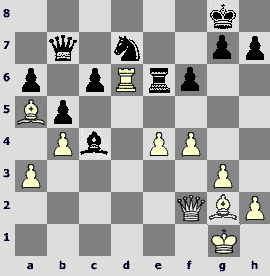
31.¦d2 An unobvious move, more resolute is 31.e5 ¦xd6 32.exd6 Ґd5 33.Ґh3 with great advantage.
31...¦e7 32.Јd4 ¤f8 33.Јd8 ¦d7 34.¦xd7 Јxd7 35.Јxd7 ¤xd7
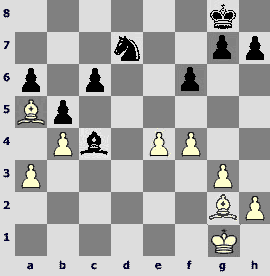
36.e5! Fine move! Again seemingly evident 36.Ґh3 ¤f8 37.Ґc8 Ґd3 38.e5 fxe5 39.fxe5 ўf7 40.ўf2 ¤e6 is worse. Black, transferring his bishop to d5, retains his chances for a draw.
36...fxe5 37.Ґxc6 ¤f6 38.Ґb7 Surely not 38.fxe5 Ґd5, with a draw.
38...exf4 39.gxf4 ¤d5
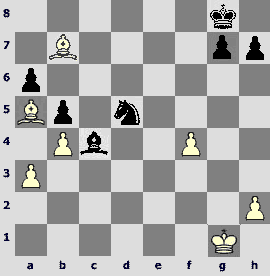
40.ўf2! Another crucial move. In spite of the limited material there seems to be no way out for Black.
40...¤xf4 41.ўe3 g5 Black fortifies the knight, but this move has its drawbacks –the g5-pawn will in time become an object for the attack.
42.Ґxa6 ўf7 43.a4 ўe7
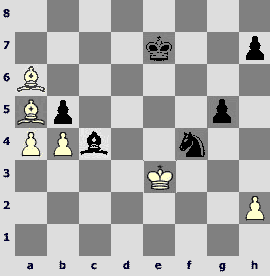
44.Ґxb5! Vladimir has precisely estimated the consequences of exchange on b5: Black cannot exchange the h2-pawn, and thus his position is lost.
44...Ґxb5 45.axb5 ўd7 46.ўe4 ¤e2 47.Ґb6 g4 48.Ґf2 ¤c3+ 49.ўf5 ¤xb5 50.ўxg4 ўe6 51.ўg5 ўf7 52.ўf5 ўe7 53.Ґc5+ A magnificent positional game.1-0
V.Topalov (2783) – D.Navara (2719) [E20]
1.¤f3 ¤f6 2.c4 c5 3.d4 cxd4 4.¤xd4 e6 5.g3 Ґb4+ 6.¤c3 ¤e4 7.Јd3 Ґxc3+ 8.bxc3 ¤c5 9.Јf3 d6 10.Ґg2 ¤bd7 11.0-0 ¤e5 12.Јf4 Ґd7 13.¤b5 Ґxb5 14.cxb5 0-0 15.¦d1 ¦c8 16.Јd4 Јc7 17.f4 ¤g4 18.c4
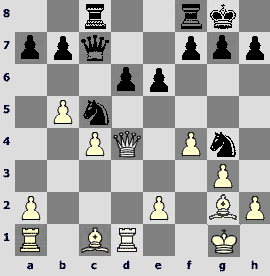
18...f5! A most unexpected but, in all probability, the strongest move. Position stays closed, and Black obtains the e4-square for the knight.
19.h3 ¤f6 20.Ґb2 ¤ce4 Surely not 20...¤fe4, in that case black knights interfere with each other.
21.Јe3 Јxc4 22.Ґxf6 gxf6 Much more accurate is 22...¦xf6, and in the rook ending after 23.Ґxe4 Јxe4 24.Јxe4 fxe4 25.¦xd6 h5 Black draws from the position of strength. 23.Ґxe4 fxe4 24.¦xd6 Јxb5
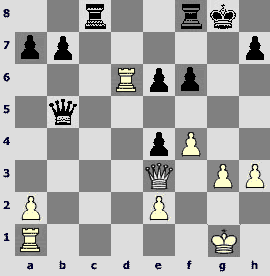
25.¦ad1 Black would have met with more problems after 25.¦xe6!, and the black king's pawn shelter becomes unreliable.
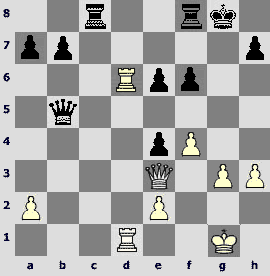
25...¦c6! 26.ўf2 Јb6! In this rook ending Black has no problems; White advantage is purely symbolic.
27.Јxb6 axb6 28.¦xc6 bxc6 29.¦d6 ўf7 30.¦xc6 h5 31.¦xb6 ¦a8 32.¦b4 ¦xa2 33.¦xe4 ¦a3 34.¦e3 ¦a4 35.ўf3 f5 36.¦b3 ўf6 37.¦b8 ¦a3+ 38.e3 ўg7 39.¦e8 ¦a6 40.¦c8 ¦a4 41.¦c6 ўf6 42.¦b6 ўf7 43.¦b8 ўg7 44.h4 ¦a3 45.¦e8 ¦a6 46.¦e7+ ўg6 47.e4 ўf6 48.¦h7 fxe4+ 49.ўxe4 ¦a3 50.¦h6+ ўf7 51.¦xh5 ¦xg3 52.¦h6 ¦h3 53.h5 ўg7 54.¦g6+ ўf7 55.¦g5 ўf6 56.¦g6+ 1/2-1/2
S.Кariakin (2678) – A.Shirov(2715) [Ґ33]
1.e4 c5 2.¤f3 ¤c6 3.d4 cxd4 4.¤xd4 ¤f6 5.¤c3 e5 6.¤db5 d6 7.Ґg5 a6 8.¤a3 b5 9.¤d5 Ґe7 10.Ґxf6 Ґxf6 11.c3 Ґg5 12.¤c2 ¤e7 13.h4 Ґh6 14.a4 bxa4 15.¤cb4 0-0 16.Јxa4

16...¤xd5?! Once again during this tournament Alexey Shirov gets mixed up into a theoretic discussion while being fully informed of the positional nuances. For the third time in a row he gets a telling blow in the opening. The correct move is 16...a5 17.¤xe7+ Јxe7 18.¤d5 Јb7
17.¤xd5 a5?! The evaluation of the position is probably depends on17...f5
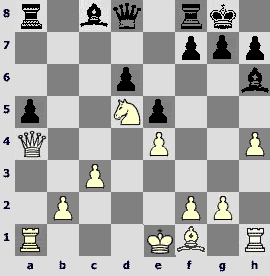
18.Ґb5! The bishop has a very strong position; it is ready to support an advancing b-pawn from c6-square.
18...ўh8 19.b4 f5 20.Ґc6 ¦a7 21.exf5 Ґxf5 22.bxa5 Ґd3 23.Ґb5 Ґxb5 24.Јxb5 ¦af7 Black forces are insufficient to create an attack on the kingside, while white a-pawn looks very much like a queen.
25.0-0 Јxh4 26.Јe2 Ґf4 To White's advantage is also 26...¦f5 27.g3 Јh3 28.Јe4 ¦h5 29.Јg2 – the threat of mate is no more, while the a-pawn is ready to move on.
27.g3 Ґxg3 28.fxg3 Јxg3+ 29.Јg2 There is no perpetual check rescue for Black. 29...¦xf1+ 30.¦xf1 ¦xf1+ 31.ўxf1 Јd3+ 32.ўg1 e4 33.Јf2 Јd1+ 34.Јf1 Јg4+ 35.ўf2 h5 36.ўe1 Јg5 37.Јc4 h4 38.a6 Јg3+ 39.ўd2 h3 40.a7 Јf2+ 41.ўc1 1-0
L.van Wely (2683) – S.Tiviakov (2667) [A29]
And now we have a possibility to watch a real grandmaster duel. Twenty years ago such games have been often guests of the elite tournaments; in the modern chess, though, the tendency to a more complex struggle prevails, sometimes even at the cost of choosing an objectively weaker course of actions.
1.c4 e5 2.g3 ¤f6 3.Ґg2 d5 4.cxd5 ¤xd5 5.¤c3 ¤b6 6.¤f3 ¤c6 7.0-0 Ґe7 8.a3 0-0 9.b4 Ґe6 10.¦b1 f6 11.d3 ¤d4 12.Ґe3 ¤xf3+ 13.Ґxf3 c6 14.Јc2 ¦f7 15.Ґc5 ¤d5 16.¤e4 b6 17.Ґxe7 ¤xe7 18.¦fd1 ¦c8 19.e3 ¤f5. Black prevents d3-d4. 20.¦bc1 ¦d7 21.Јe2 ¤e7 22.¤c3.Neither side seems to have any active plan, so it is a draw. 1/2-1/2
